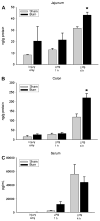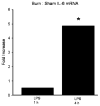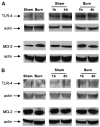Remote thermal injury increases LPS-induced intestinal IL-6 production
- PMID: 20031163
- PMCID: PMC4623587
- DOI: 10.1016/j.jss.2009.06.006
Remote thermal injury increases LPS-induced intestinal IL-6 production
Abstract
Background: Patients suffering from burn injury are at high risk for subsequent infection. Thermal injury followed by endotoxemia may result in a "second hit," causing an exaggerated inflammatory response with increased morbidity and mortality. The role of the intestine in this "second hit" response is unknown. We hypothesized that remote thermal injury increases the inflammatory response of intestinal mucosa to subsequent treatment with lipopolysaccharide (LPS).
Methods: Mice underwent sham or scald injury. Seven days after injury, mice were treated with LPS. Blood and bowel specimens were obtained. Serum and intestinal inflammatory cytokines were measured by enzyme-linked immunosorbent assay (ELISA). Changes in TLR-4 pathway components in intestine were measured by reverse transcription-polymerase chain reaction (RT-PCR), Western blot, and electrophoretic mobility shift assay (EMSA). Intestinal leukocyte infiltration was analyzed by myeloperoxidase assay.
Results: A "second hit" of injected LPS resulted in increased IL-6 in intestine of burned mice compared with sham. Similarly, jejunal IL-6 mRNA levels increased in mice with prior thermal injury, suggesting a transcriptional mechanism. Of transcription factors known to drive IL-6 expression, only AP-1 activation was significantly elevated by a "second hit" of LPS.
Conclusion: Prior thermal injury potentiates LPS-induced IL-6 cytokine production in intestine. These results indicate a heightened inflammatory response to a second hit by intestine after burn injury.
Copyright (c) 2010 Elsevier Inc. All rights reserved.
Figures





Similar articles
-
Prior thermal injury accelerates endotoxin-induced inflammatory cytokine production and intestinal nuclear factor-κB activation in mice.J Burn Care Res. 2012 Mar-Apr;33(2):279-85. doi: 10.1097/BCR.0b013e3182331d75. J Burn Care Res. 2012. PMID: 22079902 Free PMC article.
-
TLR ligand decreases mesenteric ischemia and reperfusion injury-induced gut damage through TNF-alpha signaling.Shock. 2008 Nov;30(5):563-70. doi: 10.1097/SHK.0b013e31816a3458. Shock. 2008. PMID: 18317407
-
Pentoxifylline inhibits endotoxin-induced NF-kappa B activation and associated production of proinflammatory cytokines.Ann Clin Lab Sci. 2004 Autumn;34(4):427-36. Ann Clin Lab Sci. 2004. PMID: 15648785
-
[Inhibitory effects of Kukoamine B on the inflammatory response of small intestine in lipopolysaccharide-induced septic mice and its potential mechanisms].Zhonghua Wei Zhong Bing Ji Jiu Yi Xue. 2015 Feb;27(2):121-6. doi: 10.3760/cma.j.issn.2095-4352.2015.02.009. Zhonghua Wei Zhong Bing Ji Jiu Yi Xue. 2015. PMID: 25665611 Chinese.
-
Commensal microflora induce host defense and decrease bacterial translocation in burn mice through toll-like receptor 4.J Biomed Sci. 2010 Jun 12;17(1):48. doi: 10.1186/1423-0127-17-48. J Biomed Sci. 2010. PMID: 20540783 Free PMC article.
Cited by
-
Previous burn injury predisposes mice to lipopolysaccharide-induced changes in glucose metabolism.J Burn Care Res. 2012 Sep-Oct;33(5):683-9. doi: 10.1097/BCR.0b013e31825d6a86. J Burn Care Res. 2012. PMID: 22961012 Free PMC article.
-
Lipopolysaccharide Regulation of Intestinal Tight Junction Permeability Is Mediated by TLR4 Signal Transduction Pathway Activation of FAK and MyD88.J Immunol. 2015 Nov 15;195(10):4999-5010. doi: 10.4049/jimmunol.1402598. Epub 2015 Oct 14. J Immunol. 2015. PMID: 26466961 Free PMC article.
-
Burn enhances toll-like receptor induced responses by circulating leukocytes.Int J Clin Exp Med. 2012;5(2):136-44. Epub 2012 Apr 6. Int J Clin Exp Med. 2012. PMID: 22567174 Free PMC article.
-
Salvianolate inhibits cytokine gene expression in small intestine of cirrhotic rats.World J Gastroenterol. 2011 Apr 14;17(14):1903-9. doi: 10.3748/wjg.v17.i14.1903. World J Gastroenterol. 2011. PMID: 21528066 Free PMC article.
-
Prior thermal injury accelerates endotoxin-induced inflammatory cytokine production and intestinal nuclear factor-κB activation in mice.J Burn Care Res. 2012 Mar-Apr;33(2):279-85. doi: 10.1097/BCR.0b013e3182331d75. J Burn Care Res. 2012. PMID: 22079902 Free PMC article.
References
-
- Baue AE, Durham R, Faist E. Systemic inflammatory response syndrome (SIRS), multiple organ dysfunction syndrome (MODS), multiple organ failure (MOF): Are we winning the battle? Shock. 1998;10:79. - PubMed
-
- Harris BH, Gelfand JA. The immune response to trauma. Semin Pediatr Surg. 1995;4:77. - PubMed
-
- Saffle JR, Sullivan JJ, Tuohig GM, et al. Multiple organ failure in patients with thermal injury. Crit Care Med. 1993;21:1673. - PubMed
-
- Sanucci SG, Gobara S, Santos CR, et al. Infections in a burn intensive care unit: Experience of 7 years. J Hosp Infect. 2003;53:6. - PubMed
-
- Moore FA, Moore EE. Evolving concepts in the pathogenesis of multiple organ failure. Surg Clin North Am. 1995;75:257. - PubMed
MeSH terms
Substances
Grants and funding
LinkOut - more resources
Full Text Sources
Medical
Research Materials

